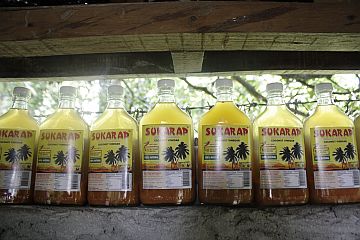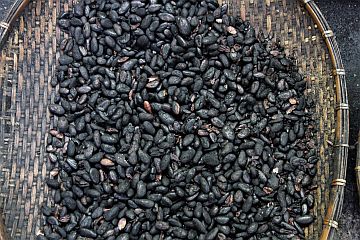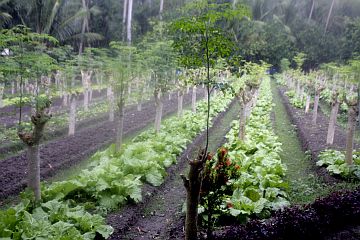
Sukarap is a kind of sauce made from days-old tuba (local wine) mixed with several spices, including chili. Best paired with fried or grilled meat.
THERE’S more to a tour of Cebu’s towns than just exploring historical sites and places of interest. One must also experience culture and tradition through the tastebuds.
Joselito “Boboi” Costas, Cebu provincial tourism officer, knows this. He said that people are more than ever getting curious about how food in a particular place is prepared and made, paving way for a growing interest in the province’s food tourism.
I was one of the lucky ones who joined a food trip to southern Cebu, along with chefs from top hotels in Cebu City for the first “Chefs’ Food Trip” organized by the Cebu provincial government. The chefs were Chef Nestor Alcoseba Jr., (Cebu City Marriott Hotel), Chef Jade Burden (Bai Hotel), Chef Coke Semblante (Radisson Blu), and Chef Orlando Santos (Cebu Parklane International Hotel).
“We would like to show to the public especially Cebuanos, that we are here to give culinary tourism a boost. We invited chefs for them to learn and discover local homegrown products, and perhaps take inspiration for a new delicacy,” Costas explained as he briefed everyone onboard the Suroy-suroy bus.
For our first stop, we travelled all the way south to the town of Argao, 67 kilometers away from the city to get a taste of the town’s best—the three Ts—torta, tablea and tuba.
We first visited the modest house of 92-year-old tablea maker and owner of Guilang Tablea, Miguela Lanotan.
Hopping from their warehouse, where the cocoa beans are roasted and ground, to an air-conditioned room which serves as their molding station, I was able to squeeze a quick visit to Nanay Miguela in her house, located a few meters away.
She is hard of hearing due to old age, but she still remembers how her business started back in 1948.

Roasted cacao beans ready for grinding. They make up the perfectly molded nibs of Guilang Tablea, which are used to make the luscious chocolate drink, “sikwate.”
It started with a few “gantang” (a measurement used back in the older times when products were measured in cups) of cocoa beans to how it eventually grew into a family business.
Tablea is defined as roasted, ground and molded nibs of fermented pure cacao beans without the added ingredients, that makes up the luscious chocolate drink or also known as the ‘’sikwate” best paired with either “puto” for Filipino breakfast, or torta, one of the town’s delicacies.
Our second stop was the backyard tuba place, Bahal Max Sukarap, owned by Rolan Sedon in Barangay Talaytay, a few minutes from the tablea house. It turned out to be the favorite part of most chefs during the trip.
Tuba is a local wine from fermented coconut sac. It is one of the main ingredients of Argao’s torta.
Aside from tuba, Bahal Max Sukarap also sells mango wine and coconut vinegars labeled Sukarap and Sulirap.
“Kulang nalang kay sud-an,” said a chef after tasting Sukarap at the cozy Chico bar.
And for our last stop, the famous torta of Argao. We went to the modest home of Jessie Magallones, where she also runs her torta-making business.
“Kung makatilaw gani mog bati nga torta, ayaw awaya ang naghimo. Sala nas tag-iya kay nag-depende nas sagol. Mas daghang itlog mas lami. Kung dili lami, gitipid mo ana,” shared Jessie as she demonstrated how to make torta.
Unlike any keeper of a homegrown delicacy recipe, Jessie wants to share her way of making Argao’s torta.
With a two-week shelf life, Jessie’s torta contains white sugar, egg yolks, melted butter, tuba, flour, and pig’s oil, which serves as the preservative of the native delicacy.
Torta has always been present in every household in the town, especially during special celebrations, like a fiesta. Its origins date back to the Spanish colonial era, when locals thought of making use of the yolk of eggs, as all the white parts were used in building the churches in the town.
ORGANIC PRODUCE IN ALEGRIA

Local farmers keep their
produce fresh at the 6,000-square-meter demo farm of the St. Peter Academy of Alegria Foundation Incorporated (SPAAFI).
After the Argao visit, we took a three-hour trip to Alegria, 57 kilometers away from the town, to visit the organic farm maintained by local farmers.
We were greeted by a downpour, as well as the smiles of farmers, who are members of St. Peter Academy of Alegria Foundation Incorporated (SPAAFI) demo farm. It sits on a 6000-square-meter lot, squeezed in between the town’s white sand beaches and abundant hills.
“Kani nga farm kay nagpamatuod nga pwede mo produce og food nga walay chemical,” said Danny Amante of SPAAFI.
The demo farm is home to organically grown vegetables like malunggay, lettuce, among others. There are also organic pigs, the manure of which are used as natural fertilizers for the vegetable garden, a process that is leading towards a healthier and safer way of farming.
Admittedly, a day tour to some of Cebu’s towns is not enough to immerse in their rich culture. But it can already provide a glimpse of what these towns can offer, especially in terms of food.
“This tour will also serve as a way to link locals to hotels, so they can have a better reach in introducing their local homegrown products,” said Costas.
